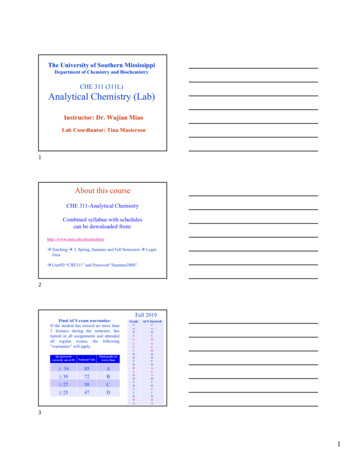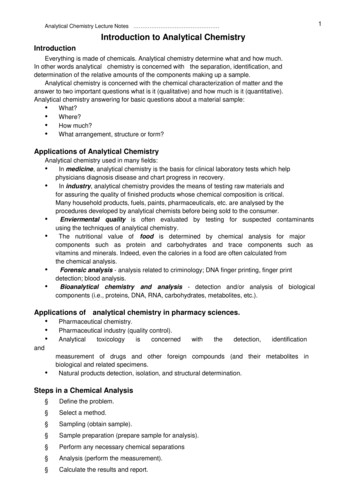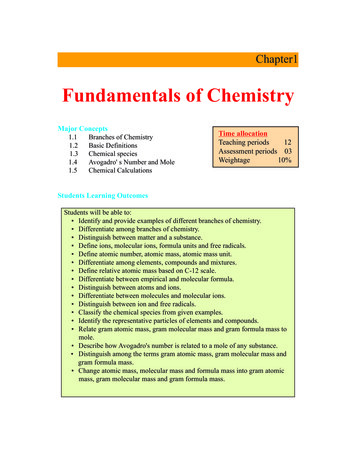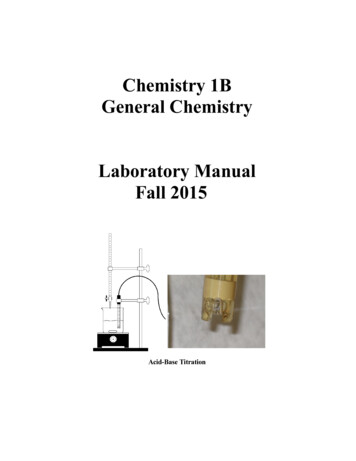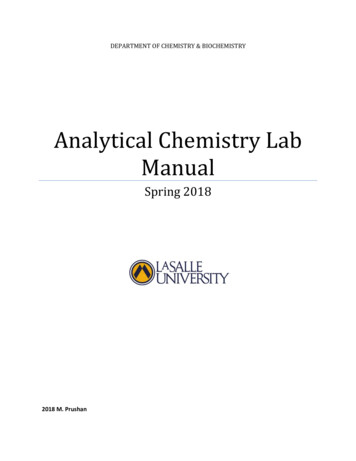
Transcription
DEPARTMENT OF CHEMISTRY & BIOCHEMISTRYAnalytical Chemistry LabManualSpring 20182018 M. Prushan
Analytical Chemistry LabLab InformationBefore each lab session, you should prepare by reading the lab manual and the textbookrequired reading. We expect you to have a good understanding of the purpose, details of theprocedure, the use of all chemicals and any significant hazards, and the underlying science ofthe experiment when you come to lab.Each Pre-lab recitation will have a prelab. Although your lab notebooks will not be checkedbefore lab drawing up tables in your lab notebook for your data and carrying out thepreparation calculations (e.g., mass needed to make up solutions of given molarities) will helpyou finish quickly and efficiently.Report FormatAlthough you are not English majors, it is still very important to be able to communicate yourscience to others. Writing poor enough to be unclear or confusing will affect your grade, as willlack of regard for grammar, punctuation, and spelling. Learn to use the spell-check facility that isbuilt into your word processing software.Here are some general comments to help you with your scientific writing. For more detail, werecommend the first chapter of the ACS Style Guide.Scientific writing is not literary writing. You should aim to be brief, precise, and unambiguous.The reader should clearly understand what you are trying to say. Try to keep your verb tenseconsistent and appropriate. You may use either passive or active voice, but try to be consistent.Avoid using jargon or slang and use full sentences. It is rare that you would need to use firstperson; i.e., try not to refer to “I”, “we”, “our”, “us”, nor should you speak about yourself, e.g.,“the student”.TitleThe Title should describe the experiment in an appropriate, adequate and concise manner.AbstractIs a summary of the goals, objectives and the results of the experiment. It should convey asense of the full report in a concise and effective manner. Remember, a reader should be ableto read the abstract and get a full sense of what was accomplished in an experiment.IntroductionConnects the basic scientific concepts being tested, or utilized in an experiment with theobjectives and purpose of the experiment. Hypotheses and logical reasoning should be given.
Data and ObservationsReport all data, including appropriate units, preferably in tabular form. Any data that wascollected digitally (i.e., using computerized data collection) should be printed out graphically asdescribed in the data analysis section of your experiment and included in your report. There isno need to print out the large data tables collected by the computer. Any data that wascollected on chart paper should be photocopied onto regular US letter size paper, reduced orenlarged if necessary, labeled appropriately, and included in your report. Do not attach longrolls of chart paper to your report. Include any relevantobservations (e.g., color changes, unintended spills, unexpected results, etc.) and note anythingyou did differently from the procedure given in this manual.Data AnalysisSee the Useful Analysis Techniques section of this manual for important information, relevantto your data analysis. Your sample calculations may be hand-written, but must be clear andlegible. Follow the analysis steps in this manual, labeling them by number so we can follow whatyou are doing. You must clearly show each step of your analysis, by writing out each equationused (the formula in words, or symbols with an explanatory key), followed by the calculationplugging in the relevant data, including the appropriate units, even if the equation is explicitlystated in the lab manual. Put a box around, underline, or in some other way highlight theimportant answers.Unless you are explicitly told otherwise in the data analysis instructions, if you studied multiplesamples, carry out all calculations for all replicates; i.e., do not average them together until thevery end. Do not show working for all replicate calculations, simply show one complete samplecalculation for the first replicate. You may then simply summarize the calculation results for theother replicates in a table or spreadsheet, making sure you label the columns well withinformative names and units. It is not necessary to show standard deviation or line of best fitcalculations, simply provide the answer from your spreadsheet/calculator. In addition to yourcalculations, your data analysis section must communicate to the reader what you are doing.There needs to be enough detail and explanation that a reader could follow your steps andreasoning and reproduce your results. State any reasoning processes that you have used thatare not described by equations, such as anywhere you used common sense, logic, bizarrethought processes to decide something (like not dropping a data point, choosing which equationbest represents your data, etc). Each step of your analysis should be clear and obvious toanyone reading your report.ResultsThis section should report the results of the experiment separately from your calculations in aclear and concise format. Where multiple data sets are used, report each individualdetermination, the average with appropriate significant figures, the standard deviation, thepercent relative standard deviation (%RSD), and the confidence interval for your data. When
using a line-of-best fit to data, report your correlation coefficient. If you Q-test away one of yourthree replicates, then you cannot report a standard deviation. That’s ok, just talk about it in yourconclusion.QuestionsWrite numbered, coherent answers to all questions found in the lab manual. Use completesentences and be sure your answer demonstrates understanding of the material. Like the rest ofyour report, the discussion section must be in your own words. Plagiarism will not be tolerated.ConclusionsThe most scientifically important part of an experiment is your interpretation of yourobservations. For an analytical chemist, the accuracy and precision of your results is alsoimportant. These priorities are reflected in the allocation of some of your lab report grade tothese topics. It may seem difficult for you to imagine what more there is to discuss once youhave determined something like the % content of ascorbic acid in a Vitamin C tablet; however,here are some guidelines to help you:Summarize the point of the experiment. (What did you do? Why did you do it?) Discuss yourresults. (Can you compare to literature values or values given by a manufacturer? Do they seemreasonable? Why or why not?) In the cases where values are available for comparison, youshould quantify the difference between your experimental values and the expected values.Rather than simply saying you were “way off”, a comment such as your value was 15% largerthan the literature value would be more appropriate. List the possible sources of error in yourexperiment, being as specific as you can in your error descriptions; e.g., rather than saying“operator error”, describe exactly what aspect of the experiment you may have done incorrectly.Discuss any problems encountered and suggest ways around them if the experiment wasrepeated. Evaluate possible sources of error (operator, random, systematic, etc.) in theexperiment. Discuss the most significant contributions to the error in this experiment anddescribe specifically how each of these significant errors would have affected your results(i.e.,increased or decreased your answers). Give reasonable methods to eliminate or reduce theseerrors. Consider the experiment in terms of accuracy, precision, reproducibility, selectivity, andanalysis time. Suggest ways to improve your procedure if you were to perform it again.ReferencesWhenever you use material written by other people to help you create your lab report, youshould reference your literature source; e.g., when you look up literature values, when you usereference information from the library, or when you read some information in a textbook tohelp you answer a discussion question. You should reference this lab manual and your textbookwhenever appropriate. All facts, formulas, drawings, graphs, etc. used in the report that you didnot create yourself require a citation of their source. Failure to reference this material has animplicit implication that they represent your original work. You should read the ScholasticDishonesty section of this manual to be sure you are clear the policies. Rarely, if ever, will youneed to directly quote material. I grade your understanding of what you have read. The ability to
find an appropriate quote is only half the battle, you must then frame it in your own words,applied to the particular experiment you have performed.Your references should be numbered in consecutive series in order of mention in your report. Ifa reference is repeated, do not give it a new number; use the original reference number.Reference numbers in the text should be superscripted outside the punctuation of the sentenceor phrase to which the citations applies, or after the name of the author if referred to in thetext; e.g.,Quantitation of chlordane in freshwater fish has been reported previously. 1When compared to previous reports of chlordane in fish,1 the results reported here Work of Doe et al.1 has shown that The complete list of literature citations should be placed at the end of your report, after theconclusions, but before the appendices. List references in numerical order and use the followingformats. More information on good reference formatting is explained in the ACS Style Guide,available at the library reference desk. Journal references must include the author names,abbreviated journal title, year of publication, volume number (if applicable), and the range ofpages of the cited article; e.g.,(1) Smith, A. D.; Moini, M. Anal. Chem. 2001, 73, 240-246.Book references must include the author or editor’s name, book title, publisher, city of publication, andyear of publication; e.g.,(2) Skoog, D. A.; Holler, F. J.; Nieman, T. A. Principles of Instrumental Analysis, 5th ed.; SaundersCollege: USA, 1998; Chapter 7.Website references must include the author (if known), title of site from browser window title bar, URL,and date accessed; e.g.,(3) U.S. Environmental Protection Agency Home Page, http://www.epa.gov/ (accessed July1996).
Useful Analysis TechniquesData rejectionWhen you have a set of data with one data point that seems very different to all the rest, theremust be a scientific basis for deciding whether to reject that point. You should not just throw itaway without justification. If you have a series of repeated measurements of the same property(e.g., when you run three replicates of an experiment), then the Q-test is a useful statistical wayto determine whether one of your points in that series of measurements can be disregarded.The Q-test tables are given in your text. (The value of Q for three observations is 0.94.) If youdo not have a series of repeated measurements of the same property, then you cannot use theQ-test.If you have no basis for rejecting a data point, other than some gut level feeling that dropping aparticular data point will make all your data look so much better, then this is what you shoulddo: Do the analysis using all your data. Show that the results using all your data are verydifferent than what you would expect. Point out how bad that one data point looks (e.g., theplot is linear except for this one point). Speculate about at least one specific experimentalreason that could explain how that data point could have been in error. Redo the analysisdropping that data point. Make self-congratulatory statements about how that fixed all yourcalculations.Data reporting in your lab reportsMost experiments in this course involve running three replicates to reduce the uncertainty inyour determined mean, and investigate the precision of your results. Use the mean of yourreplicates as your final answer; however, carry out all calculations for all replicates. Do notaverage them together until the very end. The standard deviation of the replicates is used as ameasure of how widely distributed your individual measurements have been (and by extension,would be expected to be in the future), and should be reported as a range about your meanvalue. Also, we require you to list the percent relative standard deviation (%RSD); i.e., the ratioof the standard deviation to the mean, converted to a percentage. Finally, you should quote theappropriate (stated in the procedure, usually 90 or 95% confidence interval, which is reported asthe mean value a calculated uncertainty value. Although you report both the standarddeviation and the confidence interval as ranges about your mean value; they describe verydifferent properties of your data set, and it is important in your discussion to distinguish themeanings of these two different results. Keep in mind that depending on the information sought,one or the other may provide the more appropriate measure of experimental uncertainty.Uncertainty is in the same units as the value, so quote the units after both the value and theuncertainty. If you quote your value in scientific notation, do the same for the uncertainty.When quoting your results in the two required formats (mean standard deviation and mean confidence interval), the number of significant figures quoted for the mean may differ for thetwo formats.When quoting specific values, you need to use the appropriate significant figures; i.e., ratherthan showing all the digits that have been generated during a calculation, you round youranswers in the following way. When quoting uncertainties, in general you should use only onesignificant digit, unless that significant digit would be a “1”. In this case only, use two significant
digits. When quoting your answers, you want to show all the certain digits, and only the firstuncertain digit, thus you should quote each value such that the last significant figure of yourexperimental value is of the same order of magnitude as the absolute uncertainty in thatvalue. If your uncertainty has two significant digits (i.e., the first digit is a “1”), then you shouldquote the answer such that the last significant figure of your experimental value is of the sameorder of magnitude as the second significant digit of your uncertainty. When giving your resultsin a lab report, we would expect you to quote the original experimental data with appropriatesignificant figures, and to use a reasonable number of significant figures when quoting your finalresults.Never truncate or round numbers during your calculations, even if some of the intermediatenumbers were rounded to significant figures for reporting purposes along the way. Someexperiments are treacherously susceptible to error if this rule is not followed.Introduction to the use of Analytical EquipmentElectronic BalancesUnless accuracy is not critical to the procedural step being performed, all weighing in analytical lab isperformed using a clean dry weighing bottle. Chemicals must not be weighed directly on the pan of anybalance. Only weighing bottles, weigh boats and weighing paper should contact the pan. Any chemicalthat falls on the pan will be weighed along with the chemical in the container but will not be transferredto your experiment, resulting in errors. Never try to weigh an object heavier than the capacity of yourbalance (160 grams for our Mettler balances).Temperature can affect the weight of an object. To be weighed accurately, all objects should be at roomtemperature. A warm weighing bottle will set up convection currents inside the balance case, which willbuoy up the balance pan reducing the apparent weight. In addition to the weighing bottle and itscontents, a balance also measures the weight of the column of air above the weighing bottle and this airis less dense above a hot object. Hot objects, such as crucibles, should always be cooled to roomtemperature in a desiccator (to prevent adsorption of water) prior to weighing.Weighing by DifferenceAll weighing in analytical lab is performed by difference. We do not use the TARE option on theelectronic balances. This procedure explains how to create triplicate samples of the same solid usingweighing by difference.1. Keep your balance clean. Remove dust from the pan and floor of the balance with a brush beforeweighing your sample.2. Weigh your weighing bottle with lid to get an approximate idea of its weight. Do not touch the
weighing bottle with your hands — wear gloves, or hold it using a collar of paper around the neck ofthe bottle. Close all doors on the balance before making a weight determination. Any air movementcan cause variation in weight in the mg range.3. Many solids increase their weight by taking up water vapor or carbon dioxide from the atmosphere.Some solids are provided predried in a desiccator. Remove the chemical from the desiccator. If youtry and transfer chemical from the container while still in the desiccator you are likely to spill chemicalinto the desiccator. Keep the lid on the desiccator except when actually taking things in or out of it. Donot add chemical to the weighing bottle while it is still on the balance. Place the weighing bottle onthe counter beside the balance, and use the spatula provided to transfer sample from its container toyour weighing bottle. When you are finished return the chemical container to the desiccator.4. The weighing bottle lid minimizes absorption of water vapor or carbon dioxide from the air during theweighing process. Use it. Weigh the weighing bottle along with its contents, including the lid,recording the weight using all significant figures. If the difference between this weight and the bottleweight recorded in Step 2 is not the quantity you require (roughly three times a single sample),remove the weighing bottle from the balance and add or remove chemical as appropriate. Do notreturn unused chemical back into the stock container. Put it in the solid waste.5. Remove the weighing bottle from the balance and transfer approximately one-third of its contentswithout loss directly into the first container to be used in your experiment. To transfer the solid, tipthe weighing bottle sideways over the container, and use the lid of the weighing bottle to tap gentlyon the side of the weighing bottle, until an appropriate amount of solid is transferred. Transfer shouldbe made into a container with a large enough mouth (e.g., Erlenmeyer flask) that there is no danger oflosing solid during the transfer.6. Weigh the weighing bottle and its remaining contents, including the lid, recording the weight using allsignificant figures. The weight of your first transferred sample is the difference between thisweight and the weight you measured in Step 4.7. Remove the weighing bottle from the balance and transfer approximately one-half of the remainingcontents without loss directly into the second container to be used in your experiment.8. Weigh the weighing bottle and its remaining contents, including the lid, recording the weight using allsignificant figures. The weight of your second transferred sample is the difference betweenthis weight and the weight you measured in Step 6.9. Remove the weighing bottle from the balance and transfer the remaining contents without lossdirectly into the third container to be used in your experiment.10. Weigh the weighing bottle and any residual solid, including the lid, recording the weight using allsignificant figures. The weight of your third transferred sample is the difference between this weightand the weight you measured in Step 8.11. When you have finished using the balance, make sure that all weights are recorded and clearlylabeled in your notebook, no objects are left on the balance pan, the balance and surrounding bench
top is clean, excess solid is disposed of in the solid waste container, and stock chemicals arereturned to their desiccators. Keep the balance room clean, tidy and minimize the paper you bring inthere.If a balance does not behave properly, report it to the Instructor. Do not try to fix it yourself.Volumetric GlasswareIn analytical lab all volume measurements are made using volumetric glassware. Glass is inert to mostchemicals, its coefficient of thermal expansion is small, and measurement is simplified by thetransparency of this material. There are many types of glassware; some of which is designed for holdingand transferring approximate volumes (e.g., beaker, graduated cylinder, Erlenmeyer flask, graduatedpipettes). Volumetric glassware is designed for measuring and transferring accurately known volumes ofliquids (e.g., volumetric flasks, volumetric pipettes, burets). The volumetric markings on volumetricglassware are correct to within set tolerances given in Table One below. Note that these tolerances arevalid only if the glassware is scrupulously clean.BuretsA buret is used for titrations and delivers a variable but accurately known volume (i.e., it is TDglassware). Your buret is composed of three major parts: The Barrel is the graduated tube used to holdyour solution. The Stopcock controls the rate of flow of solution out of the buret. The Tip is carefullymachined to deliver regular size drops.Cleaning your BuretThe buret is a delicate and expensive piece of glassware and should be handled carefully. If the buret isbroken in any way, it is best to replace it. In particular, each time before using your buret, checkthat there is no damage to the end of the buret tip. Any chips or cracks in a buret tip will have seriouseffects on the delivery of the titrant. Return it to the instructor if it needs to be replaced. Burets must becarefully washed with soap and water, to make sure that solutions uniformly drain down the inner
surface of the barrel. A long buret brush may be used in the barrel. Some burets allow you to removethe valve and buret tip to get easier access to both ends of the barrel. The buret is clean when there areno obvious deposits of material and if the buret drains cleanly without leaving droplets of solution on itsinner walls. Clean the tip and stopcock by repeated rinsing. If the tip or stopcock becomes clogged, theymay be unclogged by carefully pushing a piece of small diameter wire through the openings. Ifapplicable, after cleaning, reassemble your buret. Care should be taken to assure that the stopcock isfirmly seated or leakage will occur. Test for leaks by closing the stopcock, half filling the buret withdistilled water, and watching for any liquid seepage.Rinsing and Filling a BuretOnce your buret is clean and doesn't leak, it is ready for use. Solutions used in burets are usuallystandardized (i.e., their concentrations are precisely known), so in order to avoid dilution, you mustrinse your buret with your solution before filling; thus:1. Lower the buret in its holder so the top of the barrel is within easy reach. Using a funnel, pour 5 mLinto the buret from a convenient vessel (a beaker is much better than a 1 liter bottle).2. Remove your buret from its holder; tip and rotate the barrel so that the solution is brought intocontact with the entire inner surface of the buret.3. Allow the solution to drain completely out through the tip.4. Repeat with a second 5 mL wash.5. Close the stopcock and fill the buret to within 1 cm of the top.6. Let the solution sit in the barrel with the stopcock closed. Make sure that there are no leaks.7. Make sure that there are no air bubbles in either the barrel or the tip. Tap the barrel lightly todislodge air bubbles (this is an indication of a dirty buret). To remove air from the tip, open and closethe stopcock fully to force the air out. You may have to do this several times.8. Allow the solution to drain until it is within the graduated portion of the barrel.9. Label your buret with its contents, so you don't get your burets confused.10. Remove the funnel before taking any readings, or else it may drip additional solution into your barrel,destroying your volume measurement. Record the initial level of the solution in the buret. There isno reason to attempt to start each titration with the solution exactly at 0.00 mL; this practice wastestime and introduces operator bias.Once a buret has been rinsed and filled, it may be refilled as many times as necessary that same daywith the same solution without repeating the above routine. Each day and with each change of solution,the buret should be thoroughly washed with soap and water, rinsed with distilled water, rinsed with the
standard solution and filled as above. Burets are stored upside down so that material does not collect intheir tips.Reading the BuretDeterminations using a buret involve an initial and final reading; the volume used is the differencebetween these two readings. Readings must be made correctly and in the same way each time. Removeany partial drops on the buret tip by touching the tip to the inner side of your titration flask. If you havebeen delivering solution rapidly, with the stopcock fully opened, wait a few seconds for all the liquid torun down the inside walls of the barrel before taking your reading. Readings are made from the bottomof the meniscus (curvature of the liquid in the barrel) for most solutions. With highly colored solutions,you may not see the meniscus and then any other consistent point of reference may be used. Allreadings with a buret or other volumetric glassware must be made at eye level. If you have to look upor down, there will be a serious parallax error involved. Raise or lower your buret in its holder to movethe meniscus to your eye level. Your buret is graduated in 0.1 mL intervals. Read it to the nearest 0.01mL. A plain white index card held behind the buret will make it easier to read. It is also a good idea toplace a white piece of paper under your titration flask if the endpoint is being detected by an indicatorcolour change.Dispensing SolutionsAlways hold the valve joint when turning the stopcock, so the buret will not break and so that you donot pull the valve and tip out of your buret by holding it too tensely. A technique that permits speed,accuracy, and control is as follows: Face your buret with the stopcock handle on the right side of thebarrel. Operate the stopcock with your left hand from behind the buret, while swirling your solutionwith your right hand. Your left thumb and forefinger grasp the stopcock handle, while the other fingersof that hand hold the valve joint and tip steady. (Reverse for left-handers-like your professor!)Treat your first titration as a rough measurement to learn the approximate volume of titrant that willneed to be added to reach the endpoint. For subsequent titrations, you can fully open the stopcock atfirst, allowing a fast stream of solution to enter the titration flask. As the endpoint is approached, thesolution should be added more slowly, until it is added dropwise to reach a "perfect" endpoint (eachextra drop added results in 0.05 mL of error). Careful stopcock control allows dropwise addition. Becareful to ensure that each drop enters the sample solution. If you touch off a partial drop from theburet tip onto the inner wall of your sample flask, remember to rinse the partial drop down into yoursample solution using a wash bottle.
EACH EXPERIMENT IS PROVIDEDASASEPARATE DOCUMENT
Analytical Chemistry Lab . Lab Information . Before each lab session, you should prepare by reading the lab manual and the textbook required reading. We expect you to have a good understanding of the purpose, details of the procedure, the use of all chemicals and any significant hazards,

